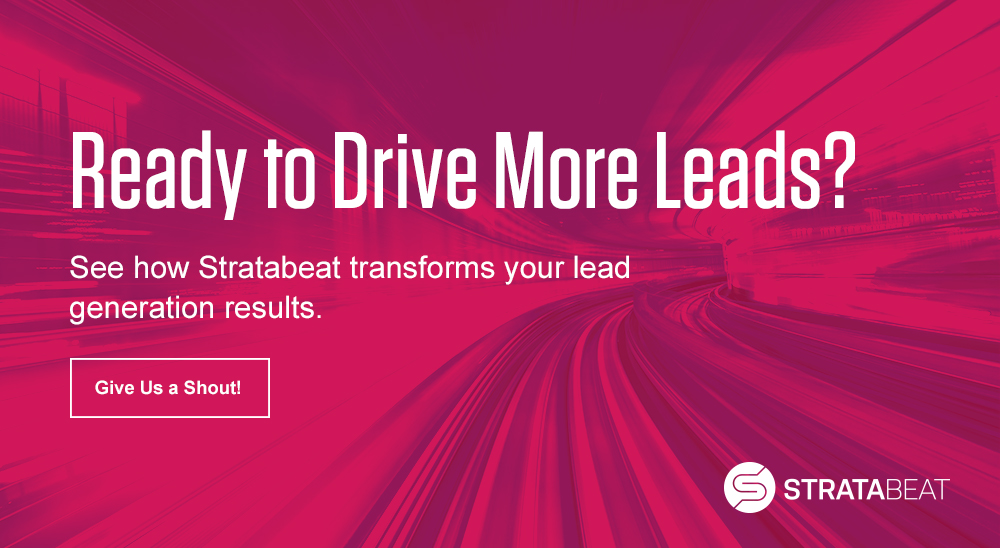The Ultimate Guide to B2B Blogging

Websites that incorporate a blog have on average 435% more indexed pages and 97% more backlinks. And marketing teams that prioritize blogging are 13X more likely to generate positive ROI. On the client side, 60% of B2B buyers confirmed that they typically consume three-to-seven pieces of content prior to engaging with a vendor.
The ROI of blogging is high.
Especially when looking at the business-to-business world, where products and services often involve a more complex buying process, the value of B2B blogging cannot be overstated.
Look no further than Zapier, which generates more than 1,900,000 monthly organic visits to its blog, supported by Google rankings on more than 510,000 keywords. All of this helped propel the business forward as they grew from a few million dollars to $50 million in annual revenue within five years of launching the blog.
Done right, B2B blogging is a lead generation engine. B2B companies that blog generate 67% more leads than those that do not.
Want to achieve greater B2B blogging success? Read this guide to understand the different levers to pull in order to transform your blog from a collection of posts into an effective lead generation platform for your business.
Define Your Audience
The first step with any exceptional B2B blog is to target your audience. There are multiple ways to target an audience, but the key is to start with audience segmentation.
Carve Out Your Audience Segments
What are the various segments you’re targeting? This may include the following types of audience segmentation:
- Problems to be solved
- Industry
- Geography
- Department
- Title
- Etc.
Map the Customer Journey
Once you’ve defined your segments, build personas for each segment. Then for each persona, build a customer journey. Identify what triggers their journey, the various steps in the process, and the main challenges to be addressed and eliminated. This will help you define the many different types of content needed for their jobs to be done (JTBD) throughout the journey.
Identify Their Specific Questions
Alfred Lukyanovich Yarbus, a Russian psychologist and author of the book Eye Movements and Vision, conducted eye-tracking studies that revealed that individuals consume information differently depending on what’s going through their minds at the time.
In one study, he showed individuals a painting and asked each individual a question prior to revealing the painting. Depending on the question asked, their eyes would look at different parts of the painting.
For example:
- If the question was “How old are the people in the painting?”, the viewer would look at the faces of the individuals in the painting.
- If, however, Yarbus asked, “What is their status in society?”, they would look at their clothing and would NOT look at their faces.
- In the case he asked, “What were the activities of the family prior to the visitor’s arrival?”, they would look at the table, piano, the person playing the piano and the person opening the door.
In other words, our eyes tend to filter out anything deemed extraneous to our mission. We instead focus on what our brain decides will help it discern the narrative logic to the question we are trying to answer.
Your blog is no different. What are the specific questions each relevant persona is asking precisely when they hit your blog post?
If you’re unsure of the questions they are asking, start to interview your customers or survey your market. You can also use tools to uncover the questions being asked online, whether in Quora or millions of Q&A and forum sites online using BuzzSumo Content Discovery (use the Questions functionality). Alternatively, you could use tools such as thruuu, AlsoAsked or Answer The Public. Or you could lean on Google itself by reviewing the People Also Ask box (Google’s built-in questions engine) when available.
Document these questions, and then make sure that you’re answering them very clearly. If you don’t make it clear that your post (or blog overall) delivers these answers, you may lose quite a number of your blog readers, who abandon the site.
Define Your B2B Blogging Goals and Strategy
Too often, B2B blogs don’t have an underlying strategy. In essence, many companies produce content merely for the sake of producing content.
The “WHY” has not been asked, nor answered. Why is the blog something your audience needs? What will it help them achieve? What opportunities will they be leaving on the table if they don’t read your blog?
Define Your Blogging Goals
Be sure your blogging goals are crystal clear, as this will guide everything that you do with your blog. Your goals will act as your decision filter for potential ideas, topics and strategies that you explore.
When you make your goals, ensure they are measurable. For example, is your blog aimed at:
- Capturing email subscribers for nurturing
- Driving qualified leads
- Increasing engagement
- Building your backlink profile
- Establishing your differentiation
- Generating brand love
- Other?
What is the timeframe in which you’ll be measuring? Weekly? Monthly? Quarterly? Annually? All of these? It’s important that you assign numerical goals to any time segment that you’ll be using.
Define Your Process Goals
In addition to these lag indicators (numbers that reflect back on what you’ve achieved), you should also define a set of leading indicators, or process goals, that provide a blueprint for the tasks that need to be done in order to hit your ultimate numerical goals. Process goals are critical to blogging success, as they are ACTIONABLE.
For example, if your goal is to increase your mailing list subscription rate by 25% for the upcoming quarter, then what are the specific tasks you need to do every day, week or month in order to hit the 25% mark? Those need to be planned, tracked and reviewed for a more reliable goals management framework.
Document Your Blog Strategy
Once your goals have been established, develop a B2B blog strategy to ensure your success in achieving those goals.
According to Content Marketing Institute’s and MarketingProfs’ 13th Annual B2B Content Marketing Benchmarks, Budgets, and Trends, 64% of the most successful B2B content marketers in the study had a documented content strategy, whereas merely 19% of the least successful did. Instituting a clear, documented strategy is an effective step for greater blogging ROI.
Strategy matters. A lot.
If you don’t have a blog strategy today, I strongly urge you to create one. If you haven’t documented it, then you don’t really have a reliable, sustainable strategy, so document it today. Take the time to define your B2B blogging strategy upfront, and not only will your blogging efforts be more efficient, your results will be far stronger, as well.
Establish Your Blogging Success Measurements
Once you’ve decided on your blogging goals and strategy, define your corresponding key performance indicators (KPIs).
Keep in mind that these should be tied to what moves the needle for your business. It’s fine having a variety of metrics that you track, but your KPIs should be the core numbers that lead to growth or alert you to red flags for the business.
7,235.7% Blog Traffic Growth
Stratabeat increased organic blog traffic by 7,235.7% for a B2B company in one of the most competitive categories in Google. See how!
For example, if the goal of your B2B blog is to capture email subscribers, then define specific monthly and quarterly KPIs for:
- New subscriber conversion rate
- New subscriber conversion rate per source
- New subscriber conversion rate per audience segment
- New qualified subscriber conversion rate per audience segment
- New subscriber-to-SQL conversion rate
Differentiation
It’s not enough to have goals for your B2B blog. You should be delivering a great deal of unique value to your audience. To achieve your goals:
- How is your blog different?
- What makes it unique?
- How are your posts better than what’s available in the top Google search results?
- What can they get from your blog that they can’t get elsewhere?
- Why would they feel compelled to come back to your blog over and over?
Blog Design & Layout
When you think of B2B blogging, your mind may initially think of text. But the reality is that the design of your blog matters. A lot.
Stratabeat maintains a database of hundreds of B2B websites. We record a range of information about each site, from overall traffic to organic traffic, the quality of design, SEO, blog, social proof and more. In our analysis of the websites in our database, we found that websites with quality design attract exponentially more traffic than sites with poor design.
Granted, this may be partly correlation rather than causation, but it’s unsurprising to see this. What are the blogs with high traffic, online shares and positive word of mouth? They tend to have a professional design. When individuals promote a piece of content, they are associating themselves with that content to some degree. It therefore follows that they logically gravitate towards those content pieces that have a higher design aesthetic and make them look better. Also, people are more likely to return to a site that looks great.
So, don’t focus exclusively on the text content of your blog. Spend time and energy ensuring that the visual aesthetic of your blog is just as powerful.
Target Keywords
In order to rank high in Google, your blog posts should each target a specific primary SEO keyword. Want to rank for “business accounting software”? Or for “endovascular stent graft”?
Then you need to target those specific keywords in what you’re writing. There’s no way around this, unless you have some way of organically generating a mountain of links with relevant anchor text. For 99% of cases, though, you’ll want to focus on your primary keyword, including it multiple times in your content piece. It should always be a natural-sounding inclusion. Never force fit it. But it does need to be included to help communicate to Google that the piece is about the particular keyword you’re targeting.
How can you identify relevant keywords to target for your blog?
You can start with the auto-complete options provided by Google when you start to type a query into the search box. Plus, use a keyword research tool like the Ahrefs Keyword Explorer, Keywords Everywhere or KWFinder for far more detailed and richer data.
The Value of Long-tail Keywords
Blogging allows you to target the long-tail in organic search, opening your site up to exponentially greater traffic. And because it can be so precisely targeted, it’s often highly qualified traffic that translates into a higher conversion rate. The higher the conversion rate, the more leads, new clients and revenue you typically generate.
Long-tail keywords are those with more words included in the query (e.g., “accounting software for small business” instead of “accounting software”) or simply with very few searches (e.g., “accounting packages”). According to an Ahrefs analysis of roughly 1.9 billion keywords, 39.33% of search demand is for the 99.84% of keywords with 1,000 or fewer monthly searches.
Given the sheer volume of long-tail searches, it behooves you to target long-tail keywords in your B2B blogging activities. It’s a way to connect with more highly qualified prospective clients, with less competition in Google.
The Tree Ring Multiplier Strategy
Think that your blog posts can rank for only a few SEO keywords? Guess again.
One of the greatest aspects of blogging and SEO is that each of your blog posts can rank for a wide range of keywords, not just your top target keyword for a post. For example, our post “Top B2B Marketing Conferences in 2023″ is currently ranking within the first three Google result pages for 32 different keywords. By optimizing your posts to rank for a range of related keywords, you get an increase in ROI from every post you write.
Compound this across dozens or hundreds of blog posts, and you’re talking about serious site traffic increases. This alone can be the difference between a site with good and one with amazing organic traffic.
So, as you’re developing new posts and optimizing old posts, use what we call the “Tree Ring Multiplier Strategy”:
- Go into Google and confirm the top-ranking organic search results for a given keyword.
- Plug these URLs into a tool such as Ahrefs or Semrush, and discover all the different keywords for which each of these content pieces ranks on Google page one. Typically, you’ll find that one high-ranking listing in Google will also rank on page one for dozens of other terms.
- Identify relevant, related keywords that have sufficient search traffic and low keyword difficulty.
- Then sprinkle these related keywords into your new post where appropriate and natural. Doing this, you give yourself the opportunity to rank for more keywords and to increase your ROI from each piece of content you write.
On-Page SEO
If you want more bang for the buck with your B2B blogging, then optimize the various elements on the page for greater organic search performance.
Blog Title
The average blogger writes about two or three potential headlines for a single blog post before settling on the final title. Yet writing more variations leads to better blog results.
Upworthy brainstorms 25 possibilities for every post title, and the site generates between roughly two and four million in monthly traffic. Clearly, brainstorming more potential blog titles helps.
For your most important posts, we recommend that you actually brainstorm 35 titles. The quality of your titles will most certainly improve with this much brainstorming investment.
In certain cases, you’re going to want a monster post in terms of capturing SEO traffic. In other cases, you might be looking to drive online shares. Or, perhaps you are writing a post that’s important from a branding perspective. If you’re limiting yourself to only two or three headlines, you’ll likely be limited to only the most obvious options.
By investing a bit of time in your blog titles, you can probably easily get to 10 options. Once you’re at 10-15, though, you’ll notice that it starts getting difficult to imagine other options. And this is precisely why it’s so important to keep pushing forward with additional ideas, as it forces you to get more creative and to think laterally. This is how you can ensure you’ve thought through a variety of different angles, whether a smarter approach to SEO or a more powerful strategy to impact would-be readers. In comparing them with each other, you’re in a much better position to select a strong title likely to generate the results you seek.
Blog URL (for SEO)
Your URL should clarify the content in the respective post. More importantly, though, for SEO purposes, keep it simple and include the target keyword in the URL itself. The goal is to make the topic as clear as possible to Google.
As Google reads left to right, try to keep the keyword as far to the left in the URL as possible, as this will indicate a heavier weighting to Google. Separate the words in the URL by dashes (e.g., stratabeat.com/blog-post-title-separated-by-dashes).
Blog Title Tag and Meta Description (for SEO)
The title tag is a Google organic ranking factor, and so you’ll want to optimize it for each post where the post offers SEO value. Include your primary keyword in your blog post’s title tag, and as with the URL, keep the keyword as far to the left in the tag as possible.
The title tag text is typically what Google will display in the search results pages, so you also want to ensure that your text is compelling, makes them want to click, aligns with search intent and is true to the actual content the searcher will find if they click through.
A meta description is not a direct ranking factor. However, it’s also what Google typically displays in the organic search results. So, you’ll want to make it as compelling as possible to increase your click-through rate (CTR). A higher CTR helps you to rank higher in the search results, as Google wants to show searchers information that they’ll find relevant and valuable. A low CTR indicates that it’s not a good fit for the search in question.
Blog Topics
With a B2B blog and B2B SEO, a key to success is going to be the specific topics that you write about. To that end, there are different techniques for coming up with topic ideas that help you generate traffic and leads, including:
- Customer Pain Points – Write about the main pain points and frustrations experienced by your target audience, and help them solve their problems. Talk to your sales team and learn what prospects are talking about.
- Skyscraper Technique – With this technique, you find a piece of content that’s performing well on a topic of interest to your audience. You then create something much better and more valuable for your audience.
- Target Keywords – As outlined above, keywords can be your Magic 8 Ball revealing how your audience is thinking and articulating their challenges. This provides you with an almost endless reservoir of potential topics to write about.
- Unique Research – Blog posts that feature unique research tend to outperform other types of posts. For one of Stratabeat’s clients in the healthcare space, for example, our research resulted in four of the five most popular blog posts in the subsequent year for the client. What’s something you could research that would be intriguing to your audience?
- Media – What is the media talking about? Are there unique angles that you could take on a topic or trend or story of interest?
- Shareability – What would your audience love so much that they would turn around and share it with others?
- Something Core to Your Brand – What’s a bold idea, attitude or approach that is a core aspect of your brand? What do you stand for? Explore posts that help communicate the DNA of your brand.
Long-form Blog Posts
If you want more online visibility and traffic, focus on creating long-form posts in your B2B blog. Depending on the keyword, long-form content tends to rank higher in Google organic search results than short-form content.
According to an Semrush Google ranking factors study, content ranking in the top 3 positions in Google is 45% longer than the content ranking in position 20 on average.
In a different Semrush study of 700,000+ articles, it was found that articles with 3,000+ words generate 3X more traffic and 3.5X more backlinks than articles that are 901-1200 words in length.
For one of our clients, we were able to take their blog from zero to 273 non-branded Google page one and page two rankings in under a year exclusively through long-tail blogging. For another client, we created their blog from scratch and drove it to roughly 30,000 monthly organic page views within 14 months through long-form content.
And remember that long-form content has value beyond SEO and traffic, as well. With long-form B2B blogging, you have more real estate on the page to play with, enabling you to include more videos or surveys or CTAs. You can drive not only greater engagement, but increased conversions, as well.
Long-Form Blogging That Gets Results
Ready to generate greater visibility, traffic, and leads from your blog? Learn more!
Evoking an Emotional Response
Want to leapfrog your competition and start generating more engagement and conversion from your B2B blog? Then look to emotions.
The Portuguese-American neuroscientist Antonio Damasio, described by The New York Times as “one of the world’s leading neurologists”, conducted studies of people with damage to the part of the brain that triggers emotions. These individuals could not feel any emotions. If you met them on the street, you wouldn’t know that anything was wrong. But these individuals couldn’t feel happy sad, angry, or excited, etc.
Through the studies, Damasio found that people with this affliction, when confronted with a choice, endlessly waffled and had an extremely difficult time making decisions.
In other words, what Damasio uncovered is that emotions are a core ingredient in decision-making (including purchase decisions). We first decide with our emotions. Only then do we apply logic to rationalize our decisions.
So, if you want your blog readers to decide to download your lead magnet, register for your upcoming webinar, subscribe to your mailing list or contact you to talk with sales, etc., then you need to evoke an emotional response from them.
Don’t make the same mistake that many B2B blogs do and publish accurate but boring content. Make it interesting, make it surprising, make it differentiated, make it exciting and make it compelling. Do what it takes to generate an emotional response.
Video
To drive greater engagement in your blog, look to video. Through behavioral analysis of session recordings of blog visitors, Stratabeat has found that our blog readers are more heavily engaged when viewing posts that include video.
Due to its engaging nature, video tends to deliver a strong marketing ROI. Aberdeen Group reports that video marketers generate 66% more qualified leads than those who don’t use video. According to a WyzOwl study, video marketing generates the following level of results:
- 91% of video marketers report that video has increased their website traffic.
- 90% of video marketers state that video has helped them generate leads.
- 92% of video marketers reported that video marketing delivers a positive ROI.
Blog Calls-to-Action (CTAs)
CTAs are your strategic tool to take your reader from a passive to an active state. Use CTAs throughout your blog to generate more engagement, leads, new customers and revenue.
It always baffles me when I come across a B2B blog that lacks CTAs. It’s like having a store but no signage outside to entice someone to come through the door.
And don’t limit yourself. You can include more than one CTA in a single post, and depending on the length and nature of your post, you can sometimes include four, five or more.
As one of our tests in the Stratabeat website, we started displaying a pop-up CTA asking our first-time blog readers to opt in to our mailing list – but only if they had scrolled down 70% of the post first. We thought that if they were finding enough value to keep scrolling and scrolling down the page, then they would probably find value in our email blasts.
In this way, behaviorally-based calls-to-action (CTA) can be very effective in that they align with the digital body language of your blog readers. The timing is everything. You hit them with a CTA at precisely the time that their behavior indicates they will be most receptive to the offer. When Stratabeat instituted the behaviorally-based CTA in our blog, mailing list opt-ins increased by more than 300%.
Beyond behaviorally-based CTAs, you can also include static CTA banners or even inline text CTAs. Stratabeat has been doing this for years in our blog, whether promoting our Rethink Your Marketing book, future of SEO playbook, B2B branding playbook, competitive advantage playbook, etc., or whether asking them to contact us. It simply makes sense to capitalize on the real estate on the page to drive additional results for the business. The key is to always make your CTAs contextually relevant to the page.
Get More Traffic & Leads!
Transform your B2B blog into a lead generation engine. Book a Strategy Call!
Behavioral Analysis
When analyzing Google Analytics or other web analytics data for a post, you’re looking at high-level results for the page as a whole. To gain deeper, more valuable insights, use behavioral analytics.
You’ll uncover not only where your site visitors are from and where they go in your site, but also what they do specifically within each page. Discover exactly where site visitors are spending the most time, moving their cursor, scrolling and clicking. View actual recordings of their sessions through your website. Based on this data, you’ll be able to make pinpoint adjustments to drive conversion rates higher.
Useful behavioral analytics packages include MouseFlow, Hotjar, FullStory and Decibel.
IP Detection
Given that a good conversion rate for a website may be 2%-10%, the majority of your blog readers are not going to convert during their visit. On the surface that looks like a lost opportunity. However, there’s a way to continue the engagement and possibly guide them towards becoming a qualified lead.
The key is to use IP detection software to identify which companies, and in certain cases, which individuals are reading your blog.
Once you know the companies that are in your blog and you see the specific posts and time-on-page for each visit, you are armed with invaluable information to reach out to relevant folks at the company to ask if they have any questions or to offer additional value on those specific topics. IP detection software packages include LeadFeeder, Lead Forensics and WhoIsVisiting. Broader, all-in-one solutions include HubSpot and Act-On.
SUMMARY: Use B2B Blogging to Drive Real Business Results
If you’re looking to gain visibility online while also driving greater traffic, leads and revenue, then you should be going “all in” on B2B blogging. A blog is a unique opportunity to expand your reach online. To engage with your audience on a deeper level. To differentiate your brand, show your personality, demonstrate your expertise and provide unique value to your audience.
And blogging enables you to achieve all of this cost effectively.
As Zapier has demonstrated through more than 1,900,000 monthly organic blog visits via 510,000 Google keyword rankings, B2B blogging gets results. Instead of viewing your blog as merely a bunch of posts, treat it as a strategic asset. An asset that gets you in front of new prospective clients, brings them to your site, starts the relationship and then transforms them into qualified leads to help you grow.
Not sure how to get started? Stratabeat is a B2B SEO agency that can help you build a blogging strategy that gets results! Schedule a call with us, to see how blogging could help your business.





